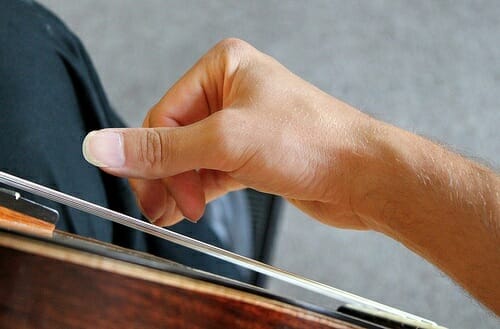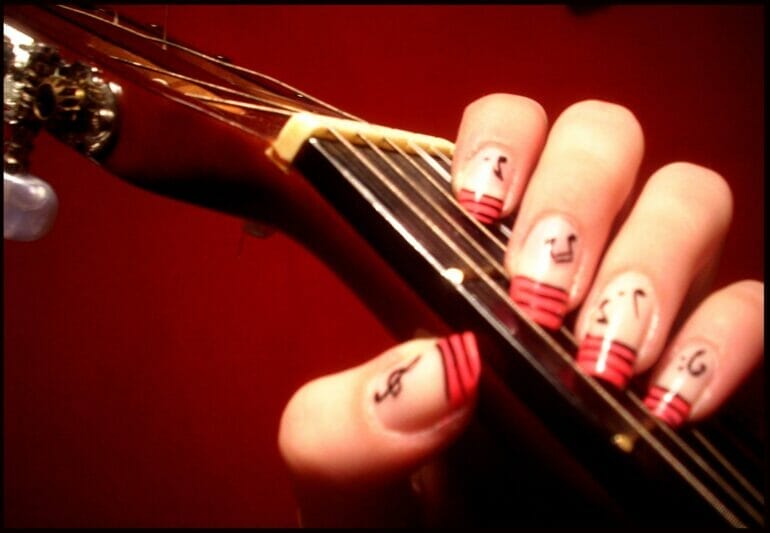Playing guitar with acrylic nails can be a challenge, but it’s definitely possible to achieve great results with a few adjustments.
Acrylic nails can make it harder to press down on the strings, but you can overcome this by using lighter gauge strings and adjusting your technique.
Opting for a shallower nail shape and keeping your nails short can also help with dexterity and reduce the chances of breakage.
Additionally, using fingerpicks, thumbpicks, or adhesive finger wraps can provide extra support and precision when playing.
Experimenting with different techniques and finding what works best for you will allow you to enjoy playing guitar to the fullest, even with acrylic nails.

Best Techniques to Play Guitar with Acrylic Nails
Playing the guitar can be a real challenge for those who have acrylic nails. While acrylic nails may enhance your overall appearance, they can hinder your ability to play the instrument comfortably. However, with the right techniques and a few adjustments, you can still enjoy playing the guitar without sacrificing your stylish nails. In this section, we will explore some of the best techniques to play guitar with acrylic nails.
1. Proper Nail Care
Before diving into the techniques, it is important to ensure that your acrylic nails are well-maintained. Keeping your nails clean and well-trimmed will not only make it easier to play the guitar but also improve the longevity of your acrylics. Regularly file your nails to maintain the desired length and shape that allows for better guitar playing.
2. Choose the Right Guitar
When playing the guitar with acrylic nails, it is crucial to select the right type of guitar. Choose a guitar with lighter strings and a lower action, as this will require less pressure on the strings to produce sound. Acoustic guitars with nylon strings or electric guitars are ideal options for guitarists with acrylic nails, as they are generally easier to play.
3. Adjust Your Technique
Adapting your playing technique is essential to accommodate acrylic nails. Here are some tips to help you adjust your technique:
- Use the pads of your fingers instead of the nails to press down on the strings. This will allow for better control and prevent your nails from interfering with the strings.
- Experiment with different angles and positions of your hand to find the most comfortable position that works for you. This may involve adjusting your wrist or elbow position.
- Avoid strumming too aggressively to prevent your nails from catching or getting stuck between the strings.
- Consider using a guitar pick to play instead of using your fingers. This can help minimize the impact on your acrylic nails.
4. Nail Protection
To prevent damage or breakage to your acrylic nails while playing the guitar, it is advisable to take some precautions:
- Apply a layer of clear nail strengthener or nail polish specifically designed to protect nails. This can provide an extra layer of protection against potential damage.
- Consider using fingerpicks or thumb picks to play the guitar. These picks fit over your nails and can help protect them from direct contact with the strings.
5. Regular Maintenance
Regularly maintaining your acrylic nails is crucial to prevent any lifting or breakage that may affect your guitar playing. Visit your nail technician regularly for touch-ups and repairs to keep your nails in optimum condition.
In summary, playing the guitar with acrylic nails may require some adjustments and additional precautions. By properly caring for your nails, choosing the right guitar, adjusting your technique, and providing adequate protection, you can enjoy playing the guitar without compromising your stylish acrylic nails. So, go ahead, strum those strings, and let your creativity flow!

Overcoming challenges of playing guitar with acrylic nails
Playing the guitar requires skill, precision, and dexterity. However, for individuals with acrylic nails, this can present a unique challenge. While acrylic nails can enhance the beauty of your hands, they can also interfere with your ability to play the guitar effectively. In this section, we will explore some common challenges faced by guitarists with acrylic nails and provide tips on how to overcome them.
1. Difficulty in fretting
One of the main obstacles faced by guitarists with acrylic nails is the difficulty in fretting the strings. Acrylic nails can make it challenging to place enough pressure on the strings to produce a clean sound. This can result in muted or buzzed notes, affecting the overall quality of your playing.
Tip: To overcome this challenge, consider shortening your acrylic nails. Opt for a shorter length that allows you to fret the strings without any hindrance. You can also try filing the underside of your nails to create a flatter surface, enabling better contact with the strings.
2. Strumming and picking issues
Another challenge faced by guitarists with acrylic nails is related to strumming and picking. Acrylic nails can interfere with the natural motion of your fingers, making it difficult to achieve the desired fluidity and precision in your strumming or picking technique.
Tip: To overcome this challenge, experiment with different hand and finger positions. Adjust the angle at which you hold the pick to find a comfortable and efficient grip. Additionally, you can try using fingerpicks or thumbpicks to enhance your strumming or picking technique.
3. Nail damage
Guitar playing can be rough on your nails, and acrylic nails are particularly vulnerable to damage. The constant contact with the strings and the pressure applied can cause acrylic nails to chip, crack, or even come off completely.
Tip: To protect your acrylic nails, consider using finger protectors or fingertip guards. These small accessories can provide a protective layer between your nails and the strings, reducing the risk of damage. Additionally, be mindful of the strength and force applied when playing the guitar to prevent unnecessary strain on your nails.
4. Nail maintenance
Maintaining acrylic nails requires regular upkeep, including fills, shaping, and polish changes. These maintenance activities can be time-consuming and may disrupt your practice or performance schedule.
Tip: To ensure that your acrylic nails do not hinder your guitar playing, plan your nail maintenance routine strategically. Schedule your nail appointments during periods when you have fewer gigs or practice sessions. This way, you can minimize any disruptions to your guitar playing routine.
5. Alternative playing techniques
If you find it challenging to play the guitar with acrylic nails, you can explore alternative playing techniques that can accommodate your nail length. Fingerstyle playing, for example, involves plucking the strings directly with your fingertips, eliminating the need for picks or long nails.
Tip: Experiment with fingerstyle playing and explore different fingerpicking patterns. This technique can not only accommodate your acrylic nails but also add a unique and melodic element to your guitar playing.
In summary, playing the guitar with acrylic nails can present certain challenges, but with proper adjustments, it is possible to overcome them. By shortening your nails, adjusting your technique, protecting your nails, and exploring alternative playing styles, you can continue to pursue your passion for playing the guitar without compromising your acrylic nails.

Nail Care for Guitarists with Acrylic Nails
Playing the guitar is a passion for many, but for guitarists with acrylic nails, it can be a bit challenging. Acrylic nails, while they can enhance the beauty of your hands, require special care to ensure that they don’t interfere with your guitar playing. In this section, we will discuss some essential tips and techniques that can help you maintain your acrylic nails while playing the guitar.
1. Choose the right length and shape
When getting acrylic nails as a guitarist, it is important to consider the length and shape of your nails. Opt for a length that allows you to comfortably press down the guitar strings without causing any pain or discomfort. Additionally, choose a shape that suits your playing style and doesn’t hinder your ability to strum or fingerpick.
2. File and shape your nails regularly
Regular filing and shaping of your acrylic nails is crucial to prevent any snags or rough edges that can interfere with your guitar playing. Use a fine-grit file to gently shape your nails, ensuring that they are smooth and even. Avoid using metal files, as they can cause damage to the acrylic material.
3. Keep your nails clean and moisturized
Proper nail hygiene is essential for guitarists with acrylic nails. Clean your nails regularly using a gentle nail cleanser or soap, and make sure to dry them thoroughly to prevent any moisture buildup. Additionally, moisturize your nails and cuticles using a nourishing nail oil or cream to keep them hydrated and healthy.
4. Protect your nails while playing
While playing the guitar, it is important to take precautions to protect your acrylic nails. Consider using fingerpicks or finger guards to minimize the direct contact between your nails and the guitar strings. This can help prevent any accidental breakage or damage to your nails while playing.
5. Avoid harsh chemicals and activities
Avoid exposing your acrylic nails to harsh chemicals or activities that can weaken the bond between the acrylic and your natural nails. This includes activities like gardening or cleaning without gloves, as well as using strong cleaning agents or solvents. Additionally, refrain from biting or picking at your nails, as this can cause them to lift or break.
6. Schedule regular maintenance appointments
Regular maintenance appointments with your nail technician are crucial for keeping your acrylic nails in good condition. They can help fill in any gaps or repairs, as well as ensure that your nails are properly balanced and shaped for optimal guitar playing. Additionally, your technician can provide guidance and recommendations specific to your nail type and playing style.
Guitarists with acrylic nails can still enjoy playing the guitar with proper care and maintenance. By choosing the right length and shape, regularly filing and shaping your nails, keeping them clean and moisturized, protecting them while playing, avoiding harsh chemicals and activities, and scheduling regular maintenance appointments, you can ensure that your acrylic nails don’t hinder your guitar playing experience. Follow these tips and continue to pursue your passion for music without any limitations!
Achieving optimal sound quality with acrylic nails on guitar
Playing guitar with acrylic nails can be a challenge for many guitarists, as it can affect the sound quality and technique. However, with the right technique and maintenance, it is possible to achieve optimal sound quality and control while playing with acrylic nails. In this section, we will discuss some tips and tricks to help you get the best possible sound while playing guitar with acrylic nails.
1. Nail shape and length
The shape and length of your acrylic nails can greatly impact the sound quality while playing guitar. It is important to ensure that your nails are shaped and filed in a way that allows for maximum control and precision when plucking the strings. The ideal nail shape for playing guitar with acrylic nails is a rounded square or oval shape, as this provides a good balance between tone and control. Additionally, keeping your nails at a moderate length can help prevent any unwanted buzzing or interference with the strings.
2. Nail maintenance
Maintaining your acrylic nails is crucial in achieving optimal sound quality. Regular filing and shaping of your nails can help prevent any rough edges or snags that can interfere with your playing. It is also important to keep your nails clean and free from any dirt or debris that can muffle the sound. Regularly moisturizing your nails and cuticles can help keep them strong and less prone to breakage, ensuring a consistent sound quality.
3. Technique adjustments
Playing guitar with acrylic nails may require some adjustments to your playing technique. One common technique adjustment is to use a lighter touch when plucking the strings. Acrylic nails can be slightly thicker than natural nails, so using a lighter touch can help prevent any unwanted muffled or dampened sounds. Experimenting with different angles and positions of your fingers can also help in finding the sweet spot that produces the best sound quality.
4. Nail care products
Using specific nail care products can enhance the sound quality while playing guitar with acrylic nails. There are various nail strengtheners and polishes available that can help improve the durability and strength of your nails. Additionally, using a top-quality guitar string cleaner can help remove any residue or oils from the strings, ensuring a clean and vibrant sound.
5. Practice and experimentation
Ultimately, achieving optimal sound quality while playing guitar with acrylic nails requires practice and experimentation. Take the time to explore different techniques, nail shapes, and lengths to find what works best for you. Recording and listening back to your playing can also help identify any areas for improvement and fine-tuning.
In summary, playing guitar with acrylic nails may require some adjustments, but with the right technique, maintenance, and experimentation, it is possible to achieve optimal sound quality. Remember to keep your nails well-maintained, adjust your playing technique if needed, and explore different nail care products to enhance the sound. With practice and perseverance, you can excel in playing guitar with acrylic nails and produce beautiful music.
FAQs
1. Can I play guitar with acrylic nails?
Yes, you can play guitar with acrylic nails. However, you might face some challenges initially due to the longer length and stiffness of the nails. It may take time to adjust your technique and find what works best for you.
2. How can I play guitar effectively with acrylic nails?
To play guitar effectively with acrylic nails, you can try the following tips: 1. Trim your nails shorter to reduce interference. 2. Experiment with different picking techniques, such as using the side of your finger or a pick. 3. Use nail files or sandpaper to shape and smooth the edges of your nails for better precision. 4. Practice regularly to develop muscle memory and improve your technique.
3. Are there any alternatives to acrylic nails for guitar playing?
Yes, if acrylic nails don’t work for you, there are alternatives such as using fingerpicks or adhesive finger pads. Fingerpicks can be attached to your fingertips to provide a similar effect to nails, while adhesive finger pads can enhance your grip and protect your natural nails.
Conclusion
In conclusion, playing guitar with acrylic nails is a unique challenge that many guitarists face. While it may require some adjustments and modifications to your technique, it is definitely possible to play the guitar effectively with acrylic nails.
Remember to take care of your nails by keeping them at a manageable length and maintaining their strength. Experimenting with different picks, choosing a suitable guitar with a lower action, and using fingerstyle techniques can help you achieve a pleasing sound without damaging your nails.
With practice and patience, you can develop a playing style that accommodates your acrylic nails and allows you to express your musical creativity to the fullest. So, don’t let your nails hold you back, embrace the challenge and enjoy making beautiful music with your guitar!
